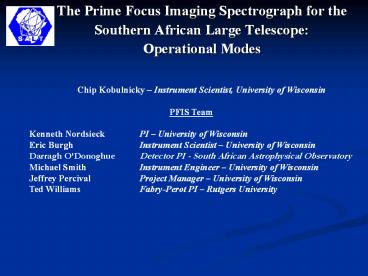The Prime Focus Imaging Spectrograph for the - PowerPoint PPT Presentation
Title:
The Prime Focus Imaging Spectrograph for the
Description:
Ted Williams Fabry-Perot PI Rutgers University. PFIS Overview ... (PI - Ted Williams, Rutgers) Polarimetry (See 4843-24 - Nordsieck et al. ... – PowerPoint PPT presentation
Number of Views:56
Avg rating:3.0/5.0
Title: The Prime Focus Imaging Spectrograph for the
1
- The Prime Focus Imaging Spectrograph for the
- Southern African Large Telescope
- Operational Modes
Chip Kobulnicky Instrument
Scientist, University of Wisconsin
PFIS Team Kenneth
Nordsieck PI University of Wisconsin Eric Burgh
Instrument Scientist University of
Wisconsin Darragh ODonoghue Detector PI - South
African Astrophysical Observatory Michael Smith
Instrument Engineer University of
Wisconsin Jeffrey Percival Project Manager
University of Wisconsin Ted Williams
Fabry-Perot PI Rutgers University
2
PFIS Overview
- First-generation, all-purpose spectrograph on the
Southern African Large Telescope (SALT).
Commissioning in fall 2004. - Optical imaging spectrograph
- 3200Å - 9000Å
- 8 Field of view
- All-refractive collimator camera
- (see 4841-164, Burgh et al., for
- optical design of PFIS)
3
PFIS Schematic
Subsystems 1. Focal Plane open longslit
custom slitmask 2. Polarization Optics open
(quartz block) ½ wave plate ¼ wave plate ½ ¼
wave plates polarizing beamsplitter 3.
Dispersive Elements none (unarticulated) 5 VPH
gratings Fabry-Perot etalon(s) 4. CCD
Detector normal readout frame transfer charge
shuffle
Planned Future Upgrade
4
PFIS Operational Modes
Forbidden modes
5
? Coverage Spectral Resolution
Contours at 90, 70, 50 efficiency. Assumes
1.25 slit, amax45 deg
Ca HK, O II kinematics z 1.6 Ly a z 1-2
restframe UV Bowen florescence
Planetary nebula kinematics abundances
Ca II stellar kinematics
Redshift surveys Nebular abundances
6
Spectral Resolution vs. Throughput
0.7 seeing
1.2 seeing
7
780 l/mm VPH grating efficiency and wavelength
coverage
-2 field angle
Field center
2 field angle
8
Readout Modes and Times
Normal readouts 4096 x 6044 pixels 3.6 s with
5e- read noise Frame Transfer 2048 x 6044
pixels 1.8 s with 5 e- readnoise
Charge transfer buffer
High Time Resolution
See 4841-052, ODonoghue et al. for detector
details
9
Fabry-Perot Spectroscopy
(PI - Ted Williams, Rutgers)
- 3 F-P Etalons
- R500 tunable filter
- R2500 (dual etalon)
- R12000 (dual etalon)
- 4300 Å 8600 Å
- Star cluster kinematics
- Galaxy cluster kinematics (zgt0.4)
- Flows in SF regions galaxies
- F-P imaging polarimetry of reflection nebulae
10
Polarimetry
(See 4843-24 - Nordsieck et al.)
Linear polarimetry ½ wave plate, 8 positions
Imaging polarimetry, 4 FOV polarimetric
surveys Longslit spectropolarimetry novae,
magnetic stars, AGN Time-resolved polarimetry
or spectropolarimetry accreting binaries,
AGN, GRB Circular polarimetry ½ wave plate (8
positions), ¼ wave plates (2 positions)
Focal Plane
Detector
2048 2048 2048
mask
4
4096
mask
11
PFIS Science Summary
Polarimetry
Fabry-Perot
Multi-object
Rapid Readout
Multi-slit spectral surveys (e.g., redshift
surveys, stellar surveys) X
Wide-field polarimetric imaging (e.g., Magellanic
Cloud surveys) X
Extreme blue ? galaxy kinematics populations
(z1-2) X
High time resolution spectroscopy (CVs, GRB, AGN)
X
High time resolution spectropolarimetry (CVs,
GRB, AGN) X X
Imaging spectropolarimetry (novae, PNe, active
galaxies) X
X
?????
12
1 Good morning, thanks for getting up so early
to be here. This talk highlights the
operational Modes and science niches for the
Prime Focus Imaging Spectrograph under design At
the university of Wisconsin destined for the
Southern African Large Telescope,
SALT. 12 Facility instrument, yet
science niches! Exciting but scary thing is
what the user will dream up to do with a
versatile instrument.
13
Signal-to-noise vs. Magnitude
14
Efficiency
15
(No Transcript)
16
(No Transcript)
17
Spectral Resolution vs. Throughput
18
(No Transcript)

